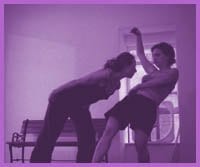Jell-O, a crutch and loneliness. Paper, a chameleon and wormholes. Nails, coconut cream pie and Axl Rose.
That’s all the direction the dancers get. The three women and one man must improvise a way of communicating the three themes they’re given. Working in pairs or groups of three or four, they demonstrate the acrobatics, intimacies and discipline of contemporary dance. Samples of “Let’s Get It On,” “One” (the Aimee Mann version) and “Lucy In The Sky With Diamonds” fill the gallery above This Ain’t The Rosedale Library.
The dancers are preparing for the upcoming performances of In Camera: Motion Gallery Experiment One, a co-production of Four Chambers, the dance company co-founded by Heidi Strauss and Darryl Tracy, and technot, a local music promotion company. In Camera (a legal term meaning in a private chamber) mixes improvisational dance with sound and visuals. Only 15 audience members will be admitted to each of the 42 shows, and just as In Camera moves beyond the boundaries of stage and choreography, it also tries to get past the idea of the passive audience.
When crowds arrive at the box office, they’ll be given a box which contains a card to fill out. There will be questions on it relating to time, anatomy, environmental conditions and action. One audience member’s card will be picked at random and his or her selections will provide the parameters of that performance. The other cards will be posted on the walls of the gallery.
Technot’s Jeremy Mimnagh, a sound and video artist, will use the chosen card to select what samples he uses. With sound, he says each performance has three or four sound ideas and each track has two or three samples. Performances begin every half hour (there’ll be a set-up, 15-minute dance and epilogue), so audiences will be kept in constant rotation. Of the nine performers involved in the project, only between one and four are scheduled for each performance. Once they begin, the audience can still do anything to influence what they see. Step in front of Strauss while she’s dancing and she’ll have to deal with it. That’s OK with her.
“This is a way for audiences to feel like they’re playing a role,” she says, “and see and understand the attempts of the performers to bring to life the things that they set forth.
“We’re trying to give them control. We’re trying to reveal things, to be personal with them, and, in that way, very human.”

 Why you can trust Xtra
Why you can trust Xtra


